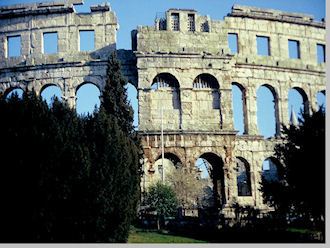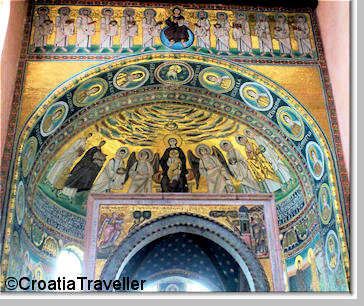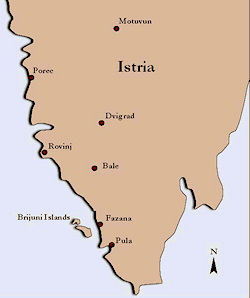
Pula Amphitheatre
Recommended Hotels
Rovinj Hotel Monte Mulini
Porec Hotel Valamar Diamant
Find Car Rentals

Euphrasian Basilica
If poking around old stones that evoke long gone days of kings and gladiators is your thing, head directly to the Istrian peninsula. From the prehistoric histri tribe to the Romans, Byzantines and Venetians, Istria reflects a fascinating panoply of cultures. This seven-day itinerary begins in Pula which has direct flights to the UK and other European destinations.
To reach some of the sights it's essential to rent a car, at least for the day, as bus service to the Istrian interior is spotty at best.

Duration: 7 days
Start: Pula
Finish: Porec
Day 1
The largest city on the Istrian peninsula with a population of about 62,000, Pula is a treasure trove of Roman ruins. Visit the Pula Amphitheatre, Hercules Gate, the Temple of Augustus, and the Arch of Sergii. More on Pula.
Day 2
Visit the Brijuni Islands National Park by driving north about 30 minutes to Fažana where a ferry boat takes you to the island of Veliki Brijun. Located 2km off the coast of the mainland, uninhabited Veliki Brijun is the largest island of the Brijuni archipelago. Note the prehistoric Bronze-Age hill fort, 1st century AD Roman residential villa, the ruins of a Byzantine castrum, and the oldest Christian building on the island (St Mary’s Basilica). More on the Brijuni Islands.
Day 3
Leave Pula and head to Rovinj. On the way, visit Nesactium Archaeological Park. Eventually conquered by the Romans in 177 BC, Nesactium was a prehistoric fortified town belonging to the Histri tribe. Possibly influenced by the Celts, the Histri traded and pirated across all of ancient Mediterranean Sea. Among the archaeological remains is an ellipsoidal hill-fort, remains of classical temples and even foundations of early Christian basilicas. After Nesactium, drive to the small town of Bale for lunch and a visit of the beautifully well-preserved 14th century Bembo Citadel. More about Bale.
Day 4
Explore beautiful Rovinj. The old town, which was fortified during the Middle Ages, was originally founded on an island. The Venetian-Gothic architecture seen throughout the town is evidence of centuries of Venetian rule. Climb up to visit stately St Euphemia Cathedral. More about Rovinj.
Day 5
Drive north to Porec. On the way, stop at Dvigrad Archaeological Park. The deserted medieval town of Dvigrad is located in the valley of Draga, central Istria. First settled in prehistoric times by the Illyrians, Dvigrad was besieged by both the Genoese and Venetians in the 14th century. In the 16th century, plague and malaria destroyed much of the living population. The town was completely abandoned by the early 18th century, probably as a result of plague and malaria. Stop for lunch in the hilltop village of Buje and admire the views over the vineyards from its walls.
Day 6
Visit the outstanding UNESCO-protected Basilica of St Euphrasius with the glittering mosaics that were emblematic of Byzantium's ‘Golden Age’. Other highlights of Porec include the remains of Roman temples and architectural highlights from Venetian rule. More about Porec.
Day 7
Drive to Motovun, Istria's most striking medieval hill town, 270m above sea level. Once inhabited by Romans, Motovun belonged to the Bishop of Poreč during the 10th and 11th centuries. In the 13th century, the Venetians surrounded the town with defensive walls that can still be seen today along with impressive Romanesque, Gothic, and Renaissance architecture. More about Motovun.
Join the Croatia Traveller Group
Recommended Experiences
©CroatiaTraveller 2005-2024 All rights reserved
